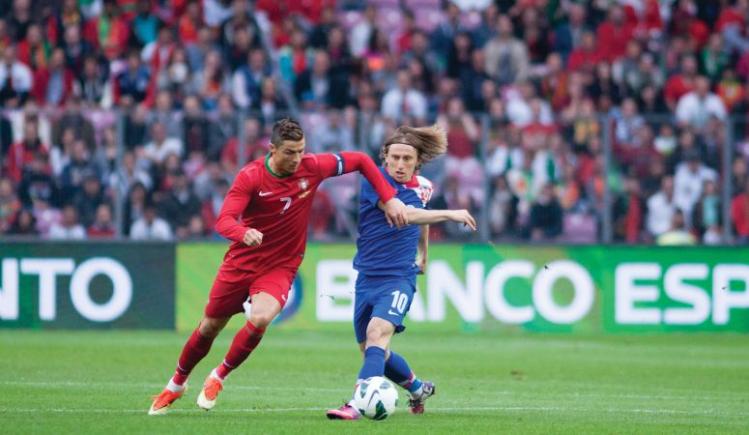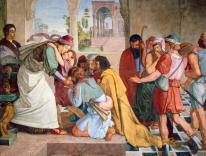
In “A Perfect Game,” his August 2010 essay in First Things, the Orthodox theologian and scholar David Bentley Hart argues that the sports we play and watch, in addition to being entertaining, also offer an aesthetic interpretation of reality—a way of enjoying the world, being in it, and seeing it. Sport orients the human vision to the transcendent; it bears an essentially metaphysical or religious content.
Hart favors the mystical, and so baseball, which invites contemplation, is his sport. Baseball’s lines open out to the infinite, and the game is not constrained by a clock; rather, one “takes in” a game. In Hart’s analysis, baseball—where teams do not battle over contested territory—lacks a martial aesthetic, and is instead liturgical and ritualistic, its movement from the first inning to the ninth embodying the circular emergence from, and return to, the infinite. Hart writes that baseball represents “a mimetic or prophetic rite that summons (or invites) the divine graciously to descend from eternity and grant a glimpse of itself within time.” The baseball season itself is liturgical, its passage from spring to fall mirroring the natural pattern of birth, growth, and death. The Fall Classic is thus both the melancholic end of a season and a look forward to a new cycle beginning in the spring.
Soccer fanatics live by a different cycle—and, you might say, a different creed. If baseball ritualizes the mind’s vertical ascent to the infinite, soccer is thoroughly horizontal. In place of the liturgical rite on the baseball diamond, the game’s essential movement is charismatic and spontaneous. Where baseball’s characteristic transcendental is the truth, soccer’s is the beautiful.
Soccer’s religious content, so to speak, is distinct. Every sport demarcates a space as its field of play, and each also has its characteristic time: space plus time plus rules equals the world of the game. In soccer, there is something approximate and flexible about this world. Spatially, though the field (or pitch, as the Brits say) must be a rectangle, its dimensions are not standardized. The regulations of the Fédération Internationale de Football Association (FIFA) specify that the two goal lines must be between 45 and 90 meters in length, and the sidelines between 90 and 120 meters. The groundskeepers who draw the chalk lines thus determine the space, and in so doing can deal out advantage: a team with dynamic attacking players benefits from a larger pitch, with room to stretch out the other team’s defense, while a defense-minded team benefits from a smaller one. The time of soccer, meanwhile, is ninety minutes of play, divided into two halves. In soccer, time’s march is never halted; fouls and injuries may stop play temporarily, but the clock goes on. At the end of each half, the official may add stoppage time, a purgatorial make-up for time lost during the game.Even then, the decision of when to blow the final whistle remains the referee’s. Thus the time of a soccer match is as fluid as its space.
Its rules are similarly malleable. Although in theory they are identical in every country and league, in reality the way officials call them varies remarkably from place to place. How much physical contact merits a foul—what merits a yellow card, and what gets a red—follows the conventions of the particular locale. And so most matches involve lobbying the referee and arguing over fair officiating. It is all up to interpretation. Unlike the “big three” American sports, soccer so far has resisted the temptation to adopt instant-replay review of calls made by its officials, choosing to remain subject to human imperfection. As Sepp Blatter, the president of FIFA who was recently suspended for ethics violations, insisted, “the referee makes the decision—a man, not a machine.” Urs Linsi, the former FIFA general secretary, notes that “Players, coaches, and referees all make mistakes,” and insists that “football’s human element must be retained. It mirrors life itself and we have to protect it.”
Soccer fans are not Luddites. Instead, they are disciples of the philosopher Henri Bergson, guided more by experience and intuition than absolutes or abstract legalisms. The soccer fan accepts that reality is what happens in the limited, human perspective of players, fans, and officials. Protecting the humanity of the game is more important than getting the call “right.” In this view, play is organic and cannot be broken into discrete “plays”—unlike in American football, where the action is divided into downs organized by the huddle and the hike, and thus easily challenged, reviewed, overturned, and set on its “right” course. With this mechanical structure, American football facilitates the human domination of space and time. In soccer, however, the chief spiritual perspective is being in the flow of time. The primacy is placed on the kairos, the opportune moment.
This attitude toward time is reflected in the tie. A sport in which there can be a 1-1 tie—or, heaven forbid, a 0-0 tie—challenges the belief that there must be an absolute winner. In soccer, an offensively weaker team may grind out a tie by “parking the bus”—that is, by playing defense with ten players in front of the ball and frustrating the designs of the stronger team. The tie respects the truth of the action on the field. Deciding games via a penalty kick shoot-out—an unfortunate necessity in tournaments, which require a winner—violates the true ethos of a game whose readiness to allow for a draw mirrors human life, with its often ambiguous outcomes.
Even as it affirms the dignity of the human within its temporal bounds, soccer manifests humanity’s contingent existence as part of the natural world. Come rain and mud, come howling winds, come blizzards—the game is not postponed. Indeed, weather and environmental variations can prove tactically useful. Central American teams use tropical environments to their advantage. On several occasions, the U.S. national team has hosted its archrival, Mexico, in Ohio—in February. Bolivian soccer clubs, well acclimated to their Andean location, have held games in La Paz, almost twelve thousand feet above sea level. A short-lived ban by FIFA on high-altitude games was overturned on the grounds that soccer must be available to everyone, wherever they live and whatever the local conditions. Soccer accepts that we are part of nature, and does not attempt to overcome or escape it.
And just as we are rooted in nature, so too does soccer both accept and exemplify the way we are rooted in culture. Though it is “the global sport,” soccer has largely resisted the homogenizing pressures of globalization; while the game is ostensibly the same on every continent, each place brings a cultural distinctiveness and unique style. It’s true that some stars migrate internationally to play in England’s Premier League, the German Bundesliga, the Spanish La Liga, or the Italian Serie A. But many play in their home country. And the national teams at major tournaments showcase regional and cultural distinctiveness in their formations, styles of play, and skill sets. The Italians historically demonstrate a genius for defense and counterattacking. Germany, the 2014 World Cup winner, unites technical prowess and discipline. The Brazilians display an open, attacking, free-flowing style of play.
What exactly is the culture of the U.S. national teams? It’s a difficult question. Some observers consider toughness to be the American soccer ethos, and it’s true that Americans often play best as underdogs against technically superior teams. The U.S. national team did precisely this in its 2006 World Cup match against Italy, the eventual tournament winners, using physical defense to gain an impressive tie against an Italian team that dominated possession of the ball. The Americans play with something to prove. The Gadsden flag waved by U.S. fans, bearing the words “Don’t Tread on Me,” sums up this chip-on-the-shoulder attitude. American forward Clint Dempsey, who once played two games with a broken jaw, typifies this toughness—as did Abby Wambach, the recently-retired star of the women’s team. Tenacity and defiance in the face of a superior foe define the spirit of American soccer.
Unfortunately, this defiance is needed most at home, where soccer perpetually struggles for a foothold. The professional domestic leagues in the United States are young, and despite its global magnitude, the World Cup tends to get lost amid the end of the NBA and NHL seasons. American soccer success on the international stage has been modest on the men’s side; and even when the U.S. women’s team brought home the World Cup in 2015, the accomplishment barely registered. Americans remain steadfast in loyalty to their homegrown sports: baseball, basketball, and American football.
This loyalty encourages some people to cast soccer as essentially European in character—as non-American, even un-American. In “Why Soccer is Un-American” (Politico, June 2014) and “How Soccer is Ruining America” (First Things, March 2009), the late theologian Stephen H. Webb argued that soccer is a “tragic” game, rooted not in American optimism, but in Old World cultural despair and the decline of Europe; as such, Webb claimed, it insults American exceptionalism. I prefer to believe that soccer elevates and purifies this exceptionalism, correcting its jingoism and its all-too-typical misuse as a thinly veiled justification for dominance over others. American soccer renounces the claim to superiority while retaining a distinctive American style. It saves American exceptionalism from itself.
This is no accident. In its fundamental spiritual orientation, soccer aspires to catholicity. Authentic catholicity reconciles the universal with the particular. It preserves the distinctive value of the particular, yet places it in relationship with the whole. Every particular contains the universal in its fullness. In this way, catholicity resists a false universal that seeks to quash local distinctiveness. This is why the problems of Western liberal modernity—how to embrace authentic diversity without falling into cultural relativism or mere proceduralism; how to bring together respect for the individual and the common good; and how to harmonize earthly goals with eternal ends—might find their answer concretely embodied on the soccer field.
IN HIS ELOQUENT apologia for baseball, David Bentley Hart criticizes what he calls “the oblong game”—those contests, including American football, rugby, hockey, basketball, and soccer, that reward the movement of a ball or object over or into a goal. The oblong game is militaristic and violent, Hart asserts, a battle for control over space. The oblong game lacks a contemplative aspect. This is admittedly true of soccer. On the soccer pitch, time is not a “moving image of eternity,” as Plato would have it. It does not seek to ascend, so to speak, through the levels of being and on to an unmoving eternity.
Soccer does possess, however, an eschatological trajectory. “Some people believe football is a matter of life and death,” Liverpool FC manager Bill Shankly once reportedly said, and went on: “I am very disappointed with that attitude. I can assure you it is much, much more important than that.” The witticism—only half-ironic—bespeaks a widespread recognition of soccer’s connection to the transcendent. Though the phrase “the beautiful game” (o jogo bonito) is traced to the Brazilian legend Pelé, it has been attributed to others too; and it is perhaps fitting that no one can rightfully claim ownership of the phrase. Soccer’s charism, so to speak, is that the eternal occurs in the midst of play, as if by grace. The primacy is on the beautiful. Who can capture beauty itself?
Certainly there is beauty in Portugal’s Cristiano Ronaldo’s free kick, in the dribbling of Spain’s Marta Viera da Silva, and in the graceful power of Ivorian Didier Drogba. In all these excellences, the skills of the game are on display. But beauty is not reducible to skill. Though it manifests itself through material conditions, true beauty is surprising, containing mysteries that physics cannot fully explain. It is charismatic, the gift of the Spirit. As the French philosopher Jean-Luc Marion states, material realities are “saturated phenomena,” through which the transcendent source is made manifest. The beautiful bleeds out and overflows the performance.
At a diminutive 5’7”, the Argentine Lionel Messi has been declared the best in the world, and possibly the best ever. Lacking size and strength, he combines quickness with a preternatural control of the ball. If you watch in slow motion, you can see the way his foot taps on the ball as he runs full speed, the microsecond shift of weight and direction that throw off the defender, the rocket to the near post. But soccer is not a phenomenon to be grasped frame by frame. It is rather a complete movement that conveys beauty, the exchange between players, their communication and communion. This movement is best described as play. As G. K. Chesterton suggests in Orthodoxy, the delight of children at play resembles God’s delight in creating. Perhaps “play” should be defined as the creaturely delight in existence. Perhaps beauty should be defined as play.
This is why true offenses in soccer—showboating, dangerous tackles, the “cynical foul,” violence—are not offenses against the rules, but against beauty itself. They are forms of idolatry, blocking the view of the beautiful, arresting our gaze and redirecting it at the individual, the skill, or the result. And idolatry is a powerful temptation in soccer.
No offense to baseball enthusiasts—none intended, anyway—but though baseball balances immense skill and intellect, its performance remains circumscribed. It is entombed in statistics, governed by inexorable laws of statistical determinism. The fourth-century writer Sallust might say of baseball, as he did of Greek myth, that it “expresses in succession what always exists.” There is nothing new in baseball, nothing that has not already occurred. Indeed, the unique occurs only in the act of breaking records—that is, through statistical accumulation. It is no surprise that the pundit George Will titled his classic book on baseball Men at Work. Baseball is serious business. And as such, though it has elements of the dramatic, it utterly lacks the charismatic.
Perhaps the basest objection to soccer is that, lacking the abundant scoring of American football or basketball, it is boring. This objection conceives no value beyond accumulation. I’ll take Abby Wambach’s last-minute headed goal in extra time against Brazil in the 2011 Women’s World Cup over any number of baskets in the NBA finals. Soccer goals do not come easily. Every shot might occasion the transcendent.
As a game of beauty, soccer thrives on the unique and the unprecedented. It is unsettled. It yearns for the transcendent, but at the same time, recognizes that the transcendent is discovered in this life. If baseball raises the contemplative gaze to the heavens, in soccer the divine overflows the terrestrial realm. Its charismatic spirit is shared with strip-mall Pentecostal churches and Sufi mystics. In this sense, the key spiritual value is living in the moment, since the beautiful can intervene at any moment.
JUNE 22 1986, MARKS the date of the infamous victory of Argentina over England in the quarterfinals of the World Cup. The longstanding rivalry between the two countries belongs to the category of the clasico, a competition between old and bitter rivals. It is the Yankees and Red Sox, amplified by nationalistic fervor. In this case that fervor was intensified still further by the 1982 English invasion and conquest of the Falkland Islands—las Islas Malvinas to the Argentines—which resulted in the deaths of 250 Britons and 650 Argentines. To the Argentines, the World Cup was the stage for revenge.
The scoreless match progressed into the second half when the Argentine star Diego Maradona dribbled through the center of the field toward England’s goal. A pass to teammate Jorge Valdano was chipped into the air between the 5’5” Maradona, who had continued his run, and the charging 6’1” Peter Shilton, England’s goalkeeper. Leaping into the air, Maradona reached the ball first, apparently heading the ball into the goal. Though the English vehemently protested, the officials never saw how Maradona’s left hand reached out and slapped the ball into goal. Argentina beat England 2-1 and would go on to win the Cup.
After the match, when replays revealed the truth, Maradona famously said that the goal had been scored “a little with the head of Maradona and a little with the hand of God.” The English were outraged. Many Argentines, in contrast, considered this act of treachery justified. Like Jacob’s trickery of Isaac to receive the blessing in place of his brutish older brother, the Argentines had outmaneuvered their hated English rivals. To be sure, the famous “mano de Dios” was a brazen violation of the rules. Yet for the Argentines, “righteousness has been manifested apart from the law” (Romans 3:21), the goal made still more perfect by virtue of being illegal. That paradox goes to the heart of soccer’s meaning. Rather than representing a human effort to rise beyond this world, soccer manifests the transcendent gift discovered within the human condition.
Speaking of the human condition, I realize—who wouldn’t, given the lurid headlines?—that FIFA has been revealed as a bastion of corruption, the nadir of wretchedness. Yet soccer remains compelling despite such lapses, or even because of them: its action gestures to a supernatural that may, at the right moment, appear within the human. If grace elevates nature, and nature yearns for grace, then only the hardest of souls would not recognize that this yearning is visible on the football pitch. This summer America hosts the Copa América Centenario, in which the U.S. men’s national team faces the most dominant teams in South and North America. Let’s root for the defiant underdogs. Let us await the beautiful.
Please email comments to [email protected] and join the conversation on our Facebook page.
Share
Previous Story
The GOP's Maddening Trump Conundrum
Next Story
Is Now the Time for Women Deacons?

